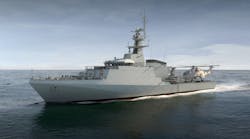Two years ago, Kelvin Hughes had its advanced SharpEye radar systems specified for three new Batch 2 River-class offshore patrol vehicles (OPVs), which were being supplied by BAE Systems to the UK’s Royal Navy, the HMS Forth, HMS Medway, and HMS Trent (see photo). More recently, the company announced that it would be providing radar systems for the two latest Batch 2 ships, the HMS Tamar and the HMS Spey, with their expanded flight decks for Merlin helicopters.
The 90-m-long vessels are based on the proven design of the earlier ships. The new ships will deploy I-band (8 to 10 GHz) radar for helicopter control and navigation for the Merlin helicopter and E/F-band (70 to 80 GHz/90 to 140 GHz) radar for ship navigation and collision avoidance.
The radar systems will interact with each ship’s Combat Management System and systems from other contractors, including the warship electronic chart display and information system (WECDIS) and wide area information server (WAIS). The Batch 2 ship radars will be complemented by automatic radar plotting aid (ARPA) widescreen displays to be installed on all Batch 2 OPVs. These well-equipped Batch 2 ships will be ready for deployment wherever needed, performing anti-piracy, counter-terrorism, and anti-smuggling roles currently conducted by Royal Navy frigates and destroyers.
The pulse Doppler SharpEye radar systems provide early warning of approaching vessels. They are capable of detecting ships of all sizes, including small wooden ones with relatively small radar cross section (RCS). Through the use of (long-wavelength) I-band frequencies, the radar systems will be capable of differentiating real targets from clutter, even under adverse weather conditions.

